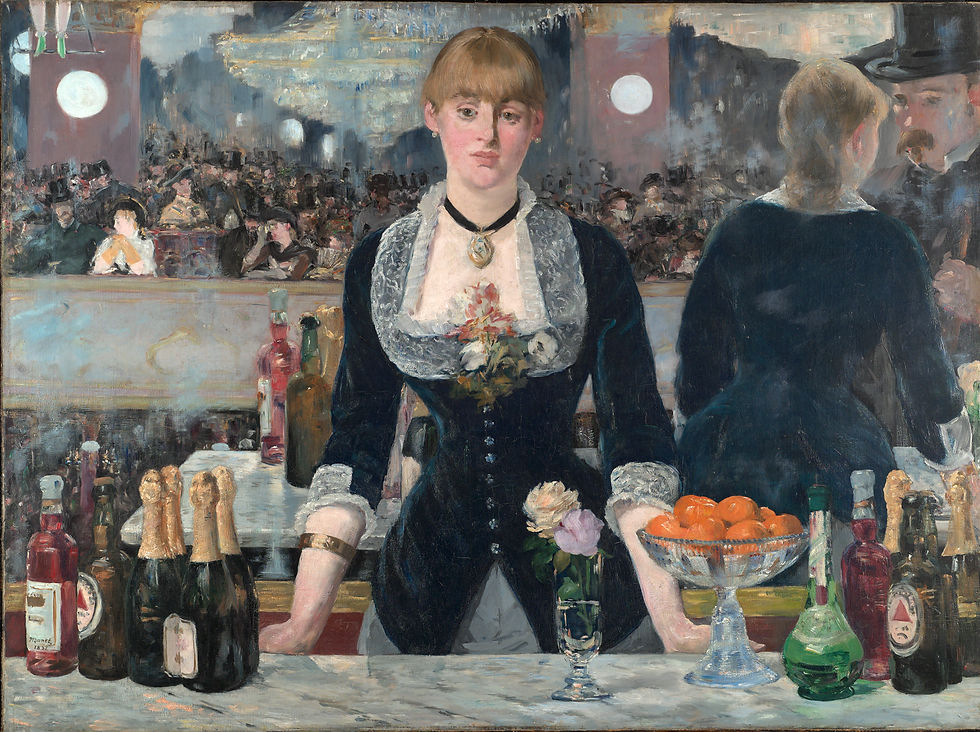Wine in Social Life and Life in Society

THE FIELD OF THE CLOTH OF GOLD
British School
ca. 1545
Royal Collection Trust, Hampton Court Palace, Molesey, Surrey, United Kingdom
In 1520, a famous meeting between Henry VIII and Francois I – that of The Field of the Cloth of Gold – took place on French soil, in the English enclave of Calais. To the right of the canvas we can see the temporary palace built for Henry VIII. A crowd has come to admire the camp and its accoutrements, such as fountains spurting wine and beer in front of the King’s palace for people's consumption.
Wine is often shown as a key part of life well lived. Wine, which “makes glad the heart of man” (Psalm 104:15) is associated with social encounters, romance, festivities and even politics. Wine is the companion of social life and life in society.
DINNER AT THE HOUSE OF M. AND MME NATANSON
(DÎNER CHEZ MONSIEUR ET MADAME NATANSON)
Henri de Toulouse-Lautrec (1864-1901)
1898
Private collection
In the 19th century, pairing good cheer with good wine became a way of honoring one’s friends. In his ‘Cultural and Social History of Wine’ (published by Larousse), Gilbert Garrier reminds us of the growing popularity of service à la russe at the end of this period. With dinners comprising eight to ten different dishes, served in quick succession, matching wine to different types of food became normal practice, upsetting culinary traditions. Foie gras, traditionally served after roasted meat, became a starter to be enjoyed with a strong, sweet wine. This would be followed by fish and seafood, a type of dish better matched with light, dry and aromatic white wines such as Chablis or Meursault,...
A BAR AT THE FOLIES-BERGERE (UN BAR AUX FOLIES-BERGÈRE)
Edouard Manet (1531-1575)
1881-1882
Courtauld Institute, Londons
Edouard Edouard Manet takes us to the Folies-Bergère. The writer Joris-Karl Huysmans, an art critic known for his outspokenness, acknowledged this painting of the bar as “certainly the most modern and interesting that this Salon [the official Salon of 1882] has to offer.” A hybrid mix of café, concert and theater, the Folies-Bergère played host to a shady clientele who drank, smoked, chatted, had fun and moved continually around the venue, from hall to arcade and from bar to auditorium. The bar made available many different alcohols, including champagne, a tried-and-tested symbol of parties and pleasure. The fashionable people were as attached as ever to the sparkling wine that they couldn’t turn down. They were on top of the world…
Find out more: Gallery Cabarets, Dance-halls and Ballrooms >>
A LADY AND TWO GENTLEMEN
Johannes Vermeer (1531-1575)
c. 1632-1675
Herzog Anton-Ulrich-Museum, Braunschweig, Germany
Vermeer elegantly portrays the private lives of silent, timeless women in a moving and naturalistic way. He would dedicate six of his thirty-five known works to the negative effects of wine. In this image, and the three others in this gallery, wine is clearly represented as an instrument of seduction (the sixth work, Young Woman Sleeping, shows the consequences of overindulgence). Many painters of the period portray women being seduced by men and wine. Wine is like a love potion which can have two effects, either mad love or paralyzing melancholy. The man sitting at the table appears to have indulged, as he seems melancholic...un
Find out more: Gallery Seduction and Love >>
THE FIGHT BETWEEN CARNIVAL AND LENT
Peter Brueghel l'Ancien (c. 1525-1569)
1559
Kunsthistorisches Museum, Vienna, Austria
Although best known for his scenes of peasant life, Peter Bruegel the Elder was also a perceptive observer of colorful countryside traditions, drawing on the visionary folklore of Jerome Bosch. Religious festivals were used as a pretext for celebration, as such events allowed the peasants to forget daily hardships. The Fight Between Carnival and Lent symbolises the passing of the ‘fat days’ before Lent. This scene of country mores uses a staged fight to caricature those who are still celebrating Carnival and those who have already started Lent. The fun-lovers are led by Carnival, a fat man sitting on a barrel. On the right, a painfully thin woman embodies the spirit of Lent. Here, the festival scene is used to represent the comédie humaine. Each of the precisely-placed, colorful figures is part of a microcosm representing the wider world…
Find out more: Gallery Celebrations and Social Life >>
LADIES CONCERT AT THE PHILARMONIC HALL
Francesco Guardi (1712-1793)
1782
Alte Pinakothek, Munich? Germany
Drinking toasts has always been a part of political life. Ulysses, King of Ithaca, would offer wine to the princes who hosted him on his voyages; Guests at Middle-Age banquets would “wish health” on each other by emptying their cups; and in the eighteenth century Bordeaux wines and frothy champagnes were adopted across the Channel for making toasts. Prior to its defeat by Napoleon in 1797, the Venetian Republic was no exception to this rule. Venice was at its peak as the most elegant and refined city in Europe... Some years later, the Venetian Francesco Guardi invites us to a Ladies Concert at the Philharmonic Hall. The son of Catherine II of Russia, the Tsarevitch Paul Petrovich and his second wife, Maria Teodorovna, are visiting Venice...
COLLECTION FROM DRINKING TO SAVOIR-BOIRE
THE VIRTUAL WINE MUSEUM'S PAINTING COLLECTIONS
> Wine and Painting > From Drinking to Savoir-boire > Social Life and Life in Society














